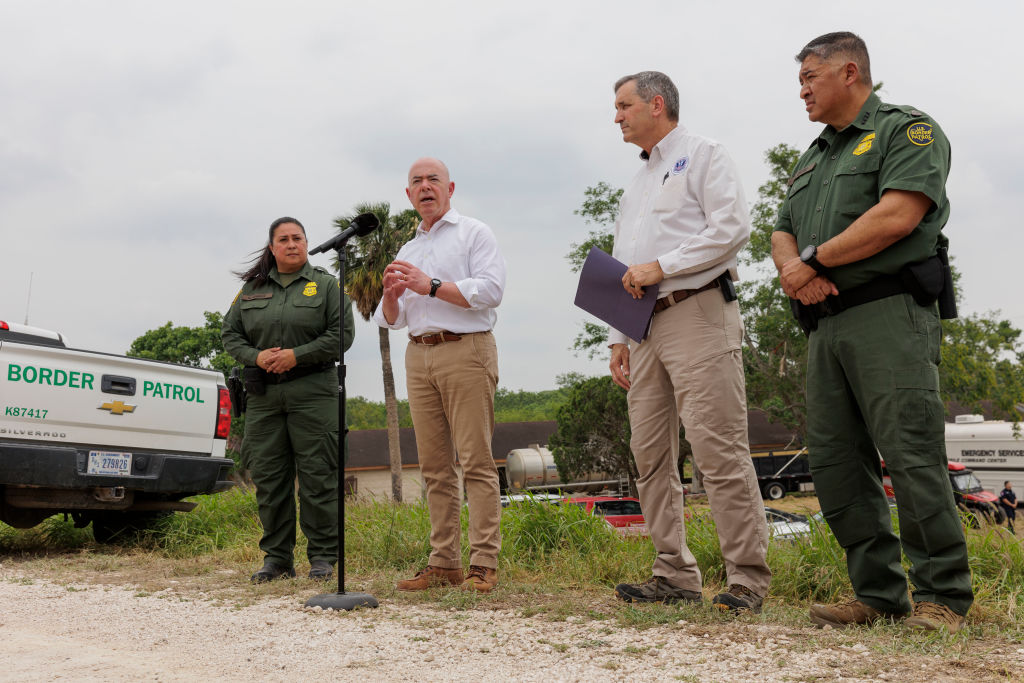The lifting of Title 42—which allowed the government to use the COVID pandemic to expel migrants for public health purposes—has not resulted in “chaos” at the border, according to most press accounts. Intended or not, this is a great example of managing expectations. Because President Joe Biden predicted things would be “chaotic for a while” after Title 42 expired, “chaos” at the border suddenly became the political metric to watch for, as if a monumental crisis absent chaos is no big deal.
On March 29, 2019, then-Homeland Security Secretary Jeh Johnson commented on 4,000 apprehensions at the border that week. “I know that a thousand overwhelms the system. I cannot begin to imagine what 4,000 a day looks like, so we are truly in a crisis.”
Last Tuesday, just before Title 42 ended, 11,000 migrants were apprehended. On Wednesday, another 11,000. On Thursday, it dropped to 10,000 and on Friday it edged down to a mere 6,200. Homeland Security Secretary Alejandro Mayorkas claimed this as proof the Biden administration’s post-Title 42 plan was working. He told ABC News on Sunday, “Over the past two days, the United States Border Patrol has seen an approximately 50 percent drop in the number of people encountered at our southern border.”
This is typical of the larger problem. A good talking point on a news show is no substitute for a successful policy. Pan out to a more meaningful unit of time, and you can see the disaster for what it is. In fiscal year 2022, a record-breaking 2.2 million migrants were apprehended, up from 1.7 million the year before.
The Biden administration seems to struggle more with the “messaging” of the crisis than the actual crisis—which is why it has often agonized about whether to use the word “crisis” at all. Mayorkas refuses to say it, preferring a “significant challenge.”
Two things have ruined this media-focused strategy. First, the reality at the border itself, shown nightly on TV, and second, the remarkably successful stunt by Republican governors of sending migrants to big cities run by Democrats. After all, if millions of migrants crowding overwhelmed border states isn’t a crisis, why should sending thousands to “sanctuary cities” be a big deal? But of course, it is a problem—which is why the mayors of New York, the District of Columbia, and Chicago have all declared emergencies, completely undermining the White House’s spin efforts.
Now, because of the end of Title 42, the administration is scrambling to come up with a real-world strategy to stem the tide. Part of that strategy, to the horror of activists and liberal Democrats, involves restoring some of Donald Trump’s most controversial immigration policies, denying entry to migrants who do not first seek asylum in a transit country (or apply for asylum before reaching the U.S. border, using an app that is unable to handle the volume of requests).
This puts Biden in a double bind. He’s already lost voters outside of his base, and now his base may come to hate his immigration policies, too. Biden’s polling on immigration is already a disaster, with his approval on the issue consistently well below his already-low overall approval. A survey of seven battleground states last month found that only 32 percent of voters approved of his handling of the issue. Embracing Trump-lite policies could erode that 32 percent without improving his standing with other voters if tangible success remains elusive.
Though it’s probably too late, one solution might be to look for bipartisanship. The administration insists its hands are tied by existing immigration law. Okay, then let’s write a new law. House Republicans just passed a very tough immigration bill that, among other provisions, would restrict asylum and restart border wall construction. The Senate would never pass it as-is, though it has sparked talk of bipartisan negotiations in the Senate. But Biden has already issued a veto threat, in part because it “does nothing to address the root causes of migration.” So now “comprehensive” immigration policy has to solve all of the political, economic, and climatological crises in South America? That’s a lot to ask. Besides, the root cause of the present crisis is the widespread, and plausible, belief that showing up at the border is worth the risk.
Allowing Republicans to have a say in immigration policy would not only buttress Biden’s constant rhapsodizing about the glories of “unity,” it would give the GOP some political ownership of the issue.
Sadly, Biden would rather continue to prattle on about unity while demonizing his opponents and unilaterally taking all the blame for the challenging situation at the border.









Please note that we at The Dispatch hold ourselves, our work, and our commenters to a higher standard than other places on the internet. We welcome comments that foster genuine debate or discussion—including comments critical of us or our work—but responses that include ad hominem attacks on fellow Dispatch members or are intended to stoke fear and anger may be moderated.